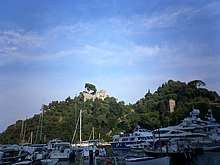Castello Brown
Castello Brown is a house museum located high above the harbour of Portofino, Italy.
| Castello Brown | |
|---|---|
 Castello Brown, as seen from the harbour | |
| Location | Via alla Penisola 16034 Portofino, Genoa Italy |
| Coordinates | 44°18′07.48″N 9°12′51.50″E |
| Built | 1557 |
| Architect | Giovanni Maria Olgiati |
 Location of Castello Brown in Northern Italy | |
The castle's site is well suited for harbour defence, and appears to have been so used since the 15th century. According to the Record Office of Genoa, cannon batteries were constructed on the site in the early 16th century, and military engineer Giovanni Maria Olgiati drew up plans for a full fortress circa 1554. The castello was completed by 1557, and, in 1575, was instrumental in turning back an attack on the town by Giò Andrea Doria. The structure was enlarged from 1622 to 1624, and survived in this form for a century and a half. The little tower was destroyed in 1798 by an English attack during Napoleon's Ligurian Republic. The castello was abandoned after the Congress of Vienna in 1815.
In 1867, the structure was purchased for 7,000 lire by Montague Yeats-Brown, then English consul in Genoa.[1] He engaged the architect Alfredo D'Andrade, and with advice from his artist friend and fellow-consul James Harris the fort was transformed to a comfortable villa without substantial alteration in its general form.[2] Yeats-Brown's descendants held the property until 1949, then sold it to an English couple, Jocelyn Baber and Lieutenant-Colonel John Baber CBE. The Babers restored several ruined sections, and in turn sold it in 1961 to the City of Portofino.[1]
Elizabeth von Arnim wrote her novel The Enchanted April at the Castello in 1922. The award-winning 1992 movie adaptation featuring Miranda Richardson and Joan Plowright was filmed on site.[1]
History
Roman fortifications from the fourth century AD have been found underneath the modern castle.[1]:63
Richard Coeur-de-Lion stayed briefly on the Third Crusade. [1]:61
The Castello withstood attacks by the Genoese (Ghibelline) admiral Aitone D'Oria in 1330, by a Venetian fleet in 1431, and by the British Navy in 1814. It was occupied by German troops until 1945, who also used it as a prison for partisans.[1]:70

| Wikimedia Commons has media related to Castle of Portofino. |
References
- Jocelyn Baber; John Baber (1965). Castello, Portofino. B.T. Batsford.:25
- "I Castelli di Portofino e di Paraggi". Archived from the original on 18 October 2014. Retrieved 18 October 2014.
- Castello Brown: Brief historical notes, undated brochure from the castello